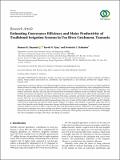Estimating Conveyance Efficiency and Maize Productivity of Traditional Irrigation Systems in Usa River Catchment, Tanzania

View/
Date
2020-07-30Author
Haymale, Humuri
Njau, Karoli
Kahimba, Frederick
Metadata
Show full item recordAbstract
Estimating the conveyance efficiency of traditional irrigation schemes systems is very important. It is because of understanding the
volume of water lost along with the transportation facility, enhancing water usage and productivity, hence making better decisions
about the utilization of water resources. (e objective of the study was to determine water abstraction permit compliances and
estimate conveyance efficiency and crop and water productivity of traditional irrigation systems in northern Tanzania. (e task
involved measurement of irrigation water flows to determine the amount of water abstraction, inflow (head) and outflow (tail)
between the canals to determine the conveyance efficiency of the main, secondary, and tertiary canals of the traditional irrigation
systems. Moreover, water and yield obtained at the farm level were determined. Results indicate that approximately 72% of water
transported reaches the destined farm which produced maize (Zea mays L) yields of 1054.5 kg/ha, 892.4 kg/ha, and 875.156 kg/ha
at downstream, midstream, and upstream which equals 0.41 kg/m3, 0.15 kg/m3, and 0.09 kg/m3, respectively, while about 28% of
water is lost along the canals through evaporation, seepage, and deep percolation and overtopping. Consequently, water measured
at furrow intakes in total was 3, 500 L/s, equal to 23% more than the permitted amount of 2856.14 L/s at Usa River Catchment.
Interventions to minimize water losses starting at the furrow’s intakes are urgently required in the current trend of the increasing
demand for water resources for food production and schemes performance. Subsequently, more effective conveyance technologies
and water management strategies other than canal lining are required.
